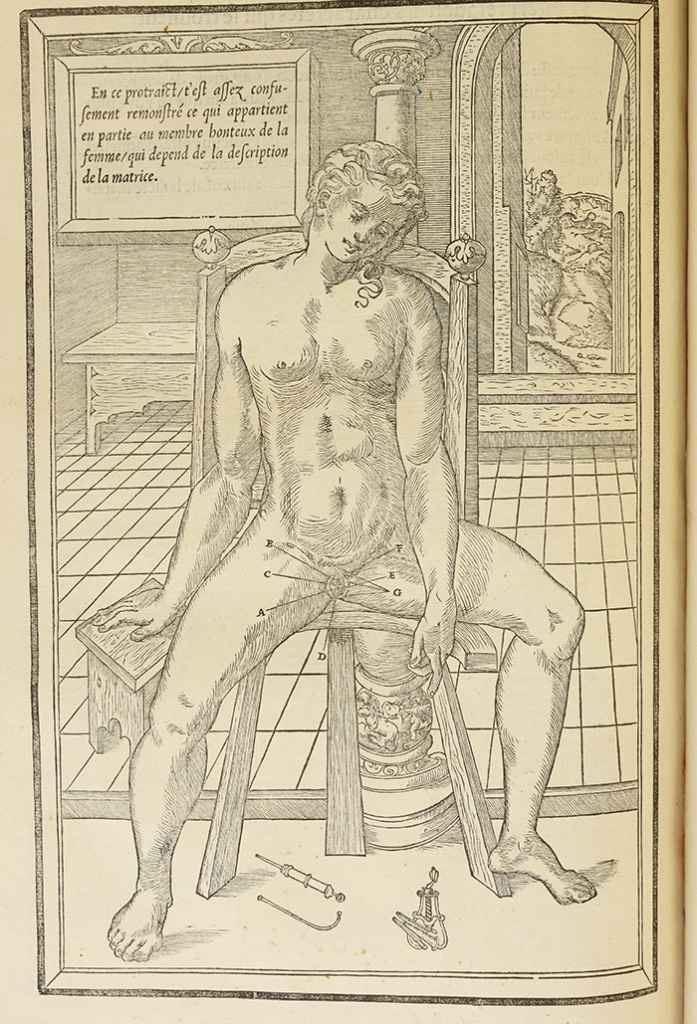The portrayal of anatomy is not necessarily objective. Anatomical atlases are products of both the individuals and the culture that produced them, and this is reflected in their pages. In some instances, anatomical texts show an association with eroticism, particularly regarding the female form.
One of the most well-known instances of this is Charles Estienne’s De dissection partium corporis humani, published in 1545. The sequence of figures depicting the anatomy of the reproductive system was famously modeled after a sequence of erotic prints by Jacopo Caraglio, in which the classical gods engaged in all sorts of sexualized behavior.

Over the course of the 18th and 19th centuries, anatomical illustration became less stylized and more dispassionate. But cultural bias did not vanish entirely. The Anatomical Basis of Medical Practice, written by Roland Frederick Becker (in no way connected to Bernard Becker!), James Wilson, and John Gehweiler, was published in 1971, but its use of the female form is more titillating than pedagogical. While the male models are posed in a straightforward manner that emphasizes the anatomical structures, the women appear in provocative poses reminiscent of pin-up girls.
Needless to say, this ill-considered choice did not go over well. In 1972, Shirley Conibear, a medical student and member of the Medical Committee for Human Rights, published a letter to the authors stating that the pictures “contribute nothing to the teaching of anatomy and everything to teaching that women are sex objects to be leered at and patronized” and asking them why they chose their illustrations.
Becker justified his decision by saying that, “None of [the] illustrations of ordinary females demonstrated good anatomical landmarks—bony prominences or muscles to any good advantage.” But this was mild compared to Wilson’s aggressive condescension. His reply began with, “Dear Miss, Mrs., or whatever you may be, Conibear,” went on to, “obviously from your correspondence you can neither read nor write the English language,” and eventually reached, “you say in your letter that male students need to learn to relate to women as human beings. The opposite is also true in that women need to relate to men, which you seem incapable of doing at the present time.”
Estelle R. Ramey, Emeritus Professor of Physiology and Biophysics at the Georgetown University School of Medicine, penned a letter to the Association of Women in Science stating that, “In effect, the entire book is a calculated insult to women and men alike. It demeans the whole profession of medicine and is openly contemptuous of middle aged women whose breasts are not so round and may even be rotting with cancer.” The AWIS as a whole threatened to boycott Williams and Wilkins Publishing, and as a result, the book was pulled.
Frank Netter’s Atlas of Human Anatomy is one of the most widely used anatomical texts today, and its illustrations are clear and straightforward. But the case of The Anatomical Basis of Medical Practice reveals that the gendered depiction of the human body that we see in early modern texts—where the male body was the “normal” body and the female body existed solely to display the reproductive organs—has persisted well into the modern era. Unfortunately, the attitudes of Becker and Wilson toward criticism reveals why this was the case—their casual disregard of Conibear’s position reveals that sexism remains deeply embedded in society, and overcoming it is an ongoing process.


